 |
||
|
||
| ||
Intel's Tera-Scale Developement In Advance New Model Names For Bearlake, A Fresh, Clear Naming Philosophy Apple Turns iPod Into iWorm, Blames Windows Final Shipment Of Intel Napa Products Set For Late 2008 Intel To Spend US$300 Million In Centrino Pro Push SiS662 To Be Adopted By MSI 662M-V Motherboard NVIDIA Unveils NVPerfKit 2.1 Suite LG Unveils Successor To "Chocolate" Mobile Phone ASUS And Cavium Networks Team Up For Powerful And Secure Servers RightMark Memory Analyzer 3.72 Released, Now with Quad-Core Kentsfield support! Intel's Tera-Scale Developement In Advance The development of personal computer is fast moving. From the simple calculation purpose in 50 years ago to entertaining PC nowadays, PC has been introduced to many fields of application. In the future, we can see PC may contribute more help in clinical research and bioinformatics technology. In IDF Spring 2005, Intel has announced Platform 2015 to suit for the needs. On the behave of Intel, Dr. Yen-Kuang Chen has told much about on the Intel Tera-Scale development, pointing out that the implement of multi-core architecture is only one of the main parts, but not in total. Tera-Scale includes 3 Tera abilities, Tera Operation Per Secord, Terabit data transfer rate in memory and I/O. These areas are impossible being implemented by SMP (Symmetric Multi-Processor) only, but also in platform and program support. 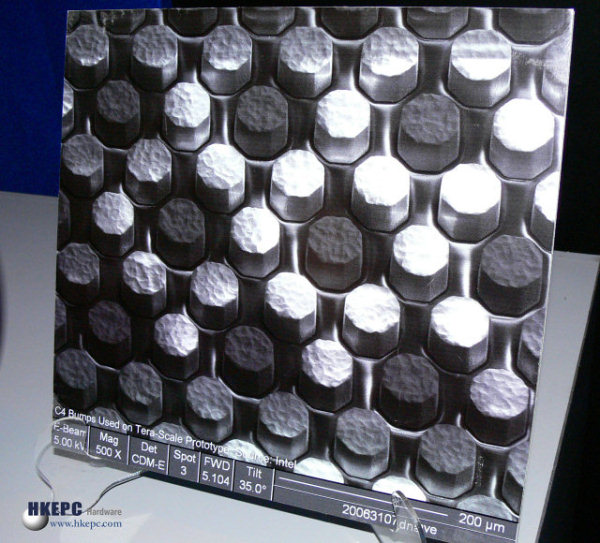 Last month, Intel has just showed research prototype silicon containing 80 simple cores and operating at 3.1 GHz. The silicon is capable up to 1 Teraflop calculation while its size is only 300mm?. Perhaps it’s one of the most important breakthroughs on reaching Tera-Scale. On a mean while, Intel also introduced the Tick-Tock models which stated that Intel would deliver new architecture and manufacturing process every 2 years. Following the Core architecture, 45nm Nehalem and 32nm Gesher architecture are upcoming in 2008 and 2010 respectively. And Core architecture will stepped into 45nm process in 2007, a step forward to Tera-Scale. Also, Intel has introduced an innovation on improving bandwidth between memory and processor. The example is a 20 megabyte SRAM memory chip that is stacked on and bonded to the processor die showed on IDF Fall 2006. Stacking the die makes possible thousands of interconnects and provides more than a terabyte-per-second of bandwidth between memory and the cores. Last, Intel is supporting universities to include parallel programming in their curriculum. It’s a goal that there will be more than 400 universities are involved, so that developers could fully utilize Intel multi-threading technology. In conclude, together with the development on these 3 areas, Tera-Scale is soon to be possible into our life. Source: HKEPC
New Model Names For Bearlake, A Fresh, Clear Naming Philosophy Since Intel admitted the existence of the next-generation chipset family, it was always been the most interest that what is the finalized product name. And now, we get it. According to a Intel’s chipset release schedule received from our source, it’s stated that Bearlake is officially named to 3 family, a new and clear naming rule. User may much easier to recognize the product segment from its model name. Similar naming started since 965 chipset, Q35 (Bearlake-Q) and Q33 (Bearlake-QF) are designed for the business segment, while X38 (Bearlake-X) is designed for extreme user and P35 (Bearlake-P) is designed for performance segment. The mentioned above will be released in Q2 2007. The next will be IGP included Q35 (Bearlake-G+) for performance segment and Q33 (Bearlake-G) for value segment, in which they will be released in Q3 2007. 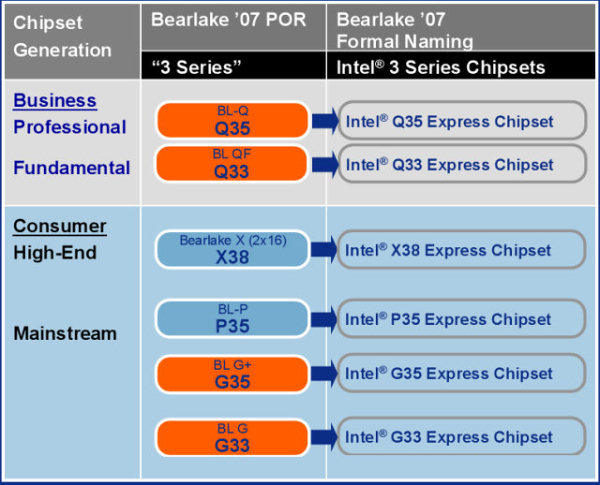 In fact, besides X38 and Q35, the rest of the Bearlake is quite similar to 965 chipset except Bearlake supports 1333MHz FSB. For X38 and Q35, the story is quite different, as they include build-in DDR2 memory controller and support for PCI-Express 2.0. While 1333MHz FSB Core 2 processor released in Q2 2007 together with Bearlake, where it is the only chipset supporting 1333MHz FSB, the life of 1066MHz FSB 965 chipset may be very short as a result. It has been too long to be waited, say half and a year, X38 is the replacement to 975X chipset. Its FSB has been enhanced to supports 1333MHz, and it also has build-in DDR2 and DDR3 memory controllers which support up to DDR2-800 and DDR3-1333. Besides, PCI-Express 2 supported in X38 results in a great improvement in internal transfer rate from 2.5Gbps to a double of 5Gbps, feeding the need for future 3D application. G35 is the first IGP with DirectX10 hardware supported. As designed for digital home, it features HDMI output with HDCP supported, and Intel Clear Video technology for Blu-Ray or HD-DVD in H.264/VC-1 HD Video. Similar to X38, both G35 and G33 also have build-in DDR2 and DDR3 controller, but a litter bit lower to DDR2-800 and DDR3-1066. In addition, with the support of 1333MHz FSB, DDR3-1333 and PCI-Express 2.0, the intrinsic Quad-Core Yorkfield upcoming in Q3 3007 will be fully empowered to a new performance level. Source: HKEPC
Apple Turns iPod Into iWorm, Blames Windows Less than a week before the fifth anniversary of its iPod, Apple Computer on Tuesday warned that some of its recently-shipped music players contained a worm that infected Windows PCs. According to a notice posted on its support site, Apple said that a small number of Video iPods made after Sept. 12 harbored a worm that slipped onto at least 25 PCs. Although Apple identified the malware as RavMonE.exe, several security companies said the Cupertino, Calif. computer maker had it wrong. "RavMonE.exe actually comes from a perfectly legitimate program called RAV Anti-Virus so it would be wrong to call a piece of malware by this name," said Graham Cluley, senior technology consultant at U.K.-based security firm Sophos. "Hackers sometimes spoof the names of legitimate programs to cause greater confusion." Both Sophos and rival McAfee said that they suspected the malware was from the RJump worm family. Apple downplayed the threat to iPod users. "A small number, less then one percent, of the Video iPods available for purchase after September 12, 2006, left our contract manufacturer carrying the virus. This known virus affects only Windows computers, and up-to-date anti-virus software which is included with most Windows computers should detect and remove it." The company took another, more direct shot at Windows, which it has lambasted in a serious of high-profile television ads. "As you might imagine, we are upset at Windows for not being more hardy against such viruses," Apple said. Ironically, an exchange last month on Apple's own discussion forums dealt with an iPod and suspected malware. "Can the iPod be infected by a virus?" asked a Windows user identified as "eculor." From "KoDor," a Mac user, came the reply: "no if you have one, yours would be the first." The iPod incident is the second this week involving malicious code found on a music player. In Japan, fast food chain McDonalds recalled more than 10,000 MP3 players that had been given as contest prizes, but which also were infected with the QQPass Trojan horse. McAfee has updated its free Stinger malware detector and destroyer to include signatures for both RJump and QQPass. Source: EETimes
Final Shipment Of Intel Napa Products Set For Late 2008 Intel will complete the last shipment of its 65nm dual-core Yonah processors used in the Napa platform in November of 2008, notebook makers familiar with Intel's latest product roadmap indicated. In addition, the last shipment scheduled for the chip maker's Sonoma products (Dothan processors) is set for February 2007, according to the makers. Intel is planning to deliver a PD (product discontinuance) notice for its Napa products in September 2007, said the makers, adding that notebook suppliers can continue placing orders until November 2007. The deadline for placing orders for Intel's Sonoma products is December of this year, the makers noted. The PD notice for Dothan CPUs was already delivered to customers in early October, said the makers. Source: DigiTimes
Intel To Spend US$300 Million In Centrino Pro Push Intel will upgrade its Centrino technology to Centrino Pro, with the launch to come with the availability of Microsoft Windows Vista OS, notebook makers said. Similar to the chip giant's marketing investment in Centrino, a total of US$300 million will be injected into Intel's worldwide sales promotion of Centrino Pro, according to the makers. Recognized as the Santa Rosa platform, Centrino Pro technology will be built around the 64-bit dual-core Merom core, said the makers citing the chip giant's latest product roadmap. In the second quarter of 2007, Intel will launch its new Core 2 Duo (Merom) CPU lineup, which includes the T7300, T7500 and T7700 models, featuring Socket P connector, 800MHz FSB and 4MB L2 cache, as well as the T7100 with 2MB of L2 cache, the makers indicated. Simultaneously, Intel's GM965/PM965 chipsets and 82566MM Gigabit Network/Wireless WiFi Link 4965AGN network chips, which all support Intel Active Management Technology (Intel AMT) and Intel Virtualization Technology (Intel VT), will be announced to complete the Santa Rosa platform, according to the makers. The pairing of Intel's Santa Rosa platform and the Microsoft Windows Vista OS will bring the most efficiency to the worldwide notebook market, Taiwan notebook makers commented. Vendors including Acer and Hewlett-Packard (HP) have significantly revamped each of their respective product design roadmaps for 2007, such as ultra-slim and one-spindle notebooks featuring 10.4-, 12.1- and 13.3-inch widescreen displays, the makers indicated. Consequently, consumer notebook orders for 2007 have drawn more attention from first-tier notebook manufacturers, according to the makers. An annual growth of the worldwide notebook market has been maintained at approximately 25%, the makers stated. In 2007, the market scale will likely top the 100 million mark, up from an estimate of 80-85 million notebooks for this year, the makers forecast. Source: DigiTimes
SiS662 To Be Adopted By MSI 662M-V Motherboard SiS today announced the implementation of its SiS662 integrated chipset into the MSI 662M-V motherboard. The MSI 662M-V is a brand new RoHS-compliant product based on SiS662/SiS966 chipsets. The MSI 662M-V motherboard supports Intel Celeron D/Pentium 4/Pentium D FSB 800 MHz processors, and also single-channel DDR2-667 memory. The SiS662 northbridge chipset supports one PCI Express x16 connection, providing 4GB/s bandwidth for each direction. Besides, it features the integrated Mirage 1 graphics engine. 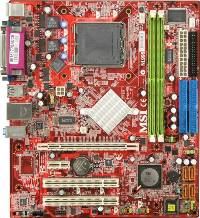 With SiS966 southbridge chipset, the MSI 662M-V motherboard supports PCI Express x1 connection as well as Serial ATA interface. It is equipped with four additional Serial ATA ports. In addition, there are eight USB2.0 ports integrated on this motherboard which fulfill the need of connecting extra devices. Furthermore, the features of the 6-channel audio and Ethernet make the MSI 662M-V motherboard more attractive for consumers. Source: SiS
NVIDIA Unveils NVPerfKit 2.1 Suite NVIDIA Corporation today announced NVPerfKit 2.1, a comprehensive suite of next-generation performance tools for the debugging and profiling of OpenGL and Direct3D software applications for Windows and Linux. Developers working on 32- and 64-bit Linux or Windows platforms can now benefit from the same technology that powers the NVIDIA NVPerfHUD performance analysis tool, a profiling and visual debugging heads-up display (HUD) program for Direct3D applications supporting Microsoft DirectX 9.0c and Windows XP on select NVIDIA graphics processing units. According to the press release, developers using NVPerfHUD 4 experience an average performance improvement of 35%, and find an average of 11 rendering bugs. By offering access to low-level performance counters inside the driver, as well as hardware counters inside the GPU, NVPerfKit 2.1 helps developers determine how applications use the GPU by identifying and confirming resolved performance issues for substantial time savings during application development. 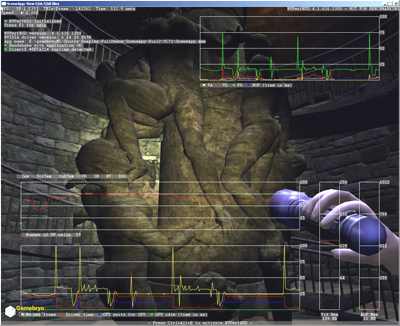 The NVPerfKit 2.1 suite of performance tools includes NVPerfHUD 4; shown here running on the Gamebryo game engine from Emergent Game Technologies. NVPerfKit 2.1 offers the following components:
The NVPerfKit 2.1 suite of performance tools is available for download at http://developer.nvidia.com/NVPerfKit. A gallery of NVPerfHUD images spotlighting top game titles is available at http://developer.nvidia.com/object/nvperfhud-screenshots.html. Source: NVIDIA Corporation
LG Unveils Successor To "Chocolate" Mobile Phone South Korea's LG Electronics Inc. unveiled a new mobile phone it hopes will replicate the success of the high selling "Chocolate" models that boosted its profit in the third quarter. Encased in silver stainless steel to differentiate it from the company's line plastic handsets, the new model, "Shine," is being released to the Korean market first, and will be available in overseas markets from early next year, LG said in a statement. "I expect this model to be as successful as the Chocolate," said Mun Hwa Park, chief executive of LG's mobile communications division, during the launch ceremony. "We hope to sell as many as 10 million units of the new phone." He did not give a timeframe for the sales target. The company will continue to produce and sell its Chocolate models, total sales of which may reach about 10 million units by the end of 2007, since being launch in October last year, Park said. LG said it has so far sold more than 4.5 million Chocolate phones globally. LG Electronics, the world's fifth-largest handset manufacturer by shipments, said Tuesday its handset division swung back to the black in the third quarter, after posting a net loss for the first six months of the year. The company attributed the rebound to robust sales of its Chocolate phones - sleekly designed models with touch controls instead of buttons and prices that are twice the average of its other models. The Shine handset, weighing 115 grams and equipped with a 2-megapixel camera, will retail at about KRW600,000 ($630) in Korea, LG said. LG sold a total 16.5 million handsets in the July-September quarter, up 7% from a year earlier. Source: LG Electronics Inc.
ASUS And Cavium Networks Team Up For Powerful And Secure Servers ASUSTeK Computer Inc. today announced the NC-C38 serverboard and N108-A1 server, which support Cavium Networks’ Octeon CN38xx MIPS-based processor to provide industry-leading network security. The N108-A1, ASUS’ first 1U rack-optimized design catering to network security, provides two different selections: the N108-A1 comes equipped with 4+4 copper-based Gigabit Ethernet ports (4 with bypass capability), and the N108-A1F offers 4 copper-based Gigabit Ethernet ports and 4 SFP fiber-based Gigabit Ethernet ports. The N108-A1 further included one PCI-X expansion slot for future upgrades. Both models provide user-friendly LCD & LED panels to deliver real-time system status and messages for convenient system management.  The NA-C38, the serverboard implemented in the N108-A1, is suitable for those who demand advanced level of customizations. Supporting different Octeon processors, RLDRAM and flexible DIMM options, it is made for configuring the best combination for various needs. Furthermore, the NA-C38 provides CF interfaces for loading RTOS and customized applications with quick boot capability. 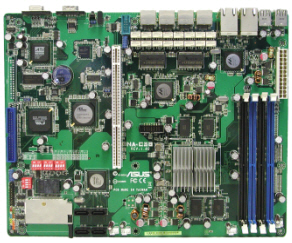 Source: ASUSTeK Computer Inc.
RightMark Memory Analyzer 3.72 Released, Now with Quad-Core Kentsfield support! The changelog includes:
RMMA, created by the RightMark Project team, is meant for measuring vital system parameters such as CPU/Chipset/RAM and providing steady and reliable (reproducible) test results. Vital low-level system characteristics include latency and real RAM bandwidth, average/minimal latency of different cache levels and its associativity, real L1-L2 cache bandwidth and TLB levels specs. 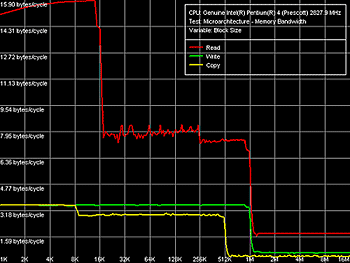 RMMA provides the following platform information:
The new version is available here, as always.
Write a comment below. No registration needed!
|
Platform · Video · Multimedia · Mobile · Other || About us & Privacy policy · Twitter · Facebook Copyright © Byrds Research & Publishing, Ltd., 1997–2011. All rights reserved. |